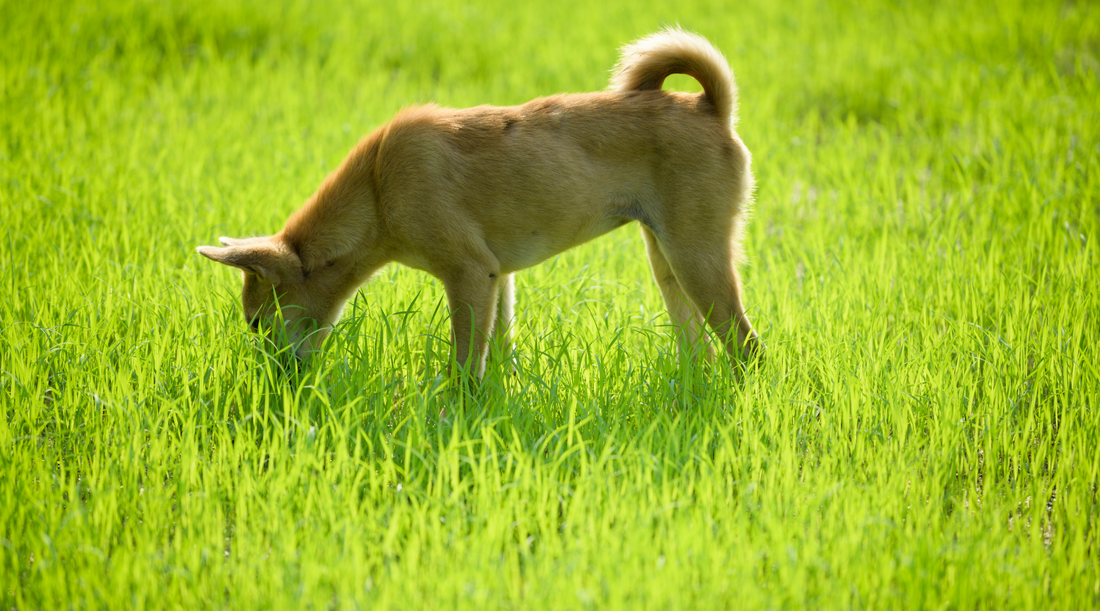
Why Is My Dog Eating Grass? Should I Be Worried?
It’s a scene many dog owners know all too well: your pup is happily running around the yard when suddenly, they stop, lower their head, and start nibbling on grass. If you’ve found yourself asking, “Why is my dog eating grass?” you’re not alone — this is one of the most Googled dog behavior questions. While it can be alarming, especially if your dog eats grass and vomits, the truth is often less dramatic than it seems.
In this article, we’ll break down the reasons why dogs eat grass, when it’s normal, when it’s a red flag, and what you can do about it.

Is It Normal for Dogs to Eat Grass?
Yes — in most cases, eating grass is completely normal dog behavior. In fact, studies have shown that up to 79% of dogs eat grass occasionally. While they are classified as carnivores, dogs are actually omnivorous scavengers, meaning their digestive systems can handle a mix of meat and plant-based foods.
Even wild canines like wolves are known to eat grass and plants, likely as a natural part of their foraging and digestion process. So, if your dog munches on grass from time to time and seems fine afterward, it’s usually not a cause for concern.
More on this topic: The Wolf: The Ecology and Behavior of an Endangered Species.
Common Reasons Dogs Eat Grass
1. To Relieve Upset Stomachs
One of the most popular theories is that dogs eat grass to induce vomiting when they’re feeling nauseous. Some dogs may instinctively try to “self-medicate” by eating rough grass, which can tickle the stomach lining and cause them to throw up.
This could explain why your dog eats grass and vomits shortly after. If this happens once in a while, it’s likely not serious — but if it becomes a pattern, consult your vet.
🐾 Tip: Keep track of how often your dog vomits after eating grass. Frequent vomiting is not normal and may indicate an underlying issue.

2. Boredom or Anxiety
Dogs are intelligent animals, and just like humans, they can act out when they’re bored or stressed. Eating grass may be a behavioral response to anxiety or lack of stimulation. This is especially common in dogs left alone for long periods or those who don’t get enough physical and mental exercise.
🐕 Solution: Increase playtime, mental enrichment (like puzzle toys), and walks to reduce grass-eating behavior driven by boredom.
3. Lack of Fiber or Nutrients
Another possibility is a dietary deficiency, especially if your dog is on processed kibble without much fiber. Grass contains insoluble fiber, which might help with digestion. Your dog could be instinctively seeking out fiber to improve gut health or relieve constipation.
If your dog regularly snacks on grass, it might be worth evaluating their food. Look for high-quality dog food or consider adding fiber-rich natural supplements (like pumpkin or flaxseed).
🐶 Tip: Some pet parents choose to support their dog’s digestion with natural supplements formulated to balance gut health and reduce instinctive grass-eating behavior.
Our probiotics are packed with dog-safe fiber and natural greens — developed to support healthy digestion and reduce grass cravings. Plus, they're tasty enough to be used as daily treats.
4. They Simply Like the Taste or Texture
Sometimes, the reason is the simplest one: your dog might just enjoy the taste or texture of grass. Fresh, cool blades might feel nice on their tongue, or it might be part of their natural foraging instinct.
In this case, the behavior is typically harmless — as long as the grass isn’t treated with pesticides or chemicals.
When Should You Worry?
While grass-eating is usually normal, there are a few red flags to watch out for:
 ❗ 1. Frequent Vomiting
❗ 1. Frequent Vomiting
If your dog eats grass and vomits frequently, it could be a sign of gastrointestinal distress, parasites, or a more serious illness like inflammatory bowel disease (IBD).
❗ 2. Changes in Appetite or Behavior
If your dog starts eating grass obsessively and also seems lethargic, loses weight, or refuses to eat, it’s time for a vet visit.
❗ 3. Exposure to Toxic Grass or Plants
Make sure your dog isn’t eating grass treated with pesticides, herbicides, or fertilizers, which can be toxic. Also, beware of toxic plants (like lilies or foxglove) that could be growing in your garden or on walks.
Is It Bad for Dogs to Eat Grass?
In moderation and under safe conditions, eating grass is not bad for dogs. However, it's essential to:
-
Ensure the grass is chemical-free
-
Monitor how often it happens
-
Rule out underlying health or behavioral issues
-
Supplement their diet if nutritional gaps are suspected
What Can You Do About It?
Here are some practical steps you can take if your dog is a regular grass-eater:
✅ 1. Check Their Diet
Ensure your dog’s food has enough fiber, nutrients, and real ingredients. You may want to supplement their diet with omega-3s, probiotics, or natural multivitamins if their current food lacks variety.
✅ 2. Provide More Mental Stimulation
Try adding new toys, scent games, training exercises, or even dog-friendly enrichment mats. These can reduce stress and boredom — two common triggers for grass eating.
✅ 3. Offer Healthy Alternatives
Give your dog chew toys, dental sticks, or safe vegetables like cucumber slices to see if they gravitate toward those instead of grass.
✅ 4. Keep a Log
Note when and where your dog eats grass. Does it happen after eating? Only on walks? Is it linked to stressful events? This info can help your vet make a better diagnosis if needed.
Final Thoughts
So, why is your dog eating grass? It could be for digestion, boredom, taste, or even a natural behavior rooted in their ancestry. In most cases, it’s not a cause for panic — especially if your dog is otherwise healthy and happy.
However, if you notice vomiting, behavioral changes, or signs of nutritional imbalance, don’t ignore it. A vet check-up, a change in diet, or adding supplements can make a real difference.
At the end of the day, understanding your dog’s behavior — even something as seemingly strange as grass-eating — helps you become a more informed, caring pet parent.

